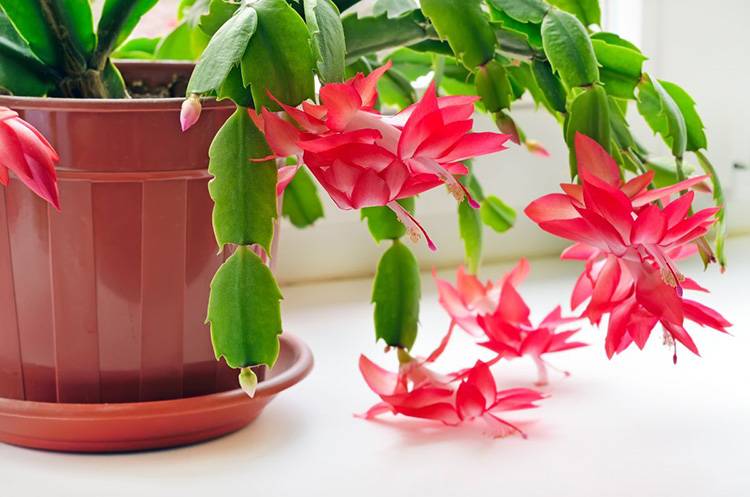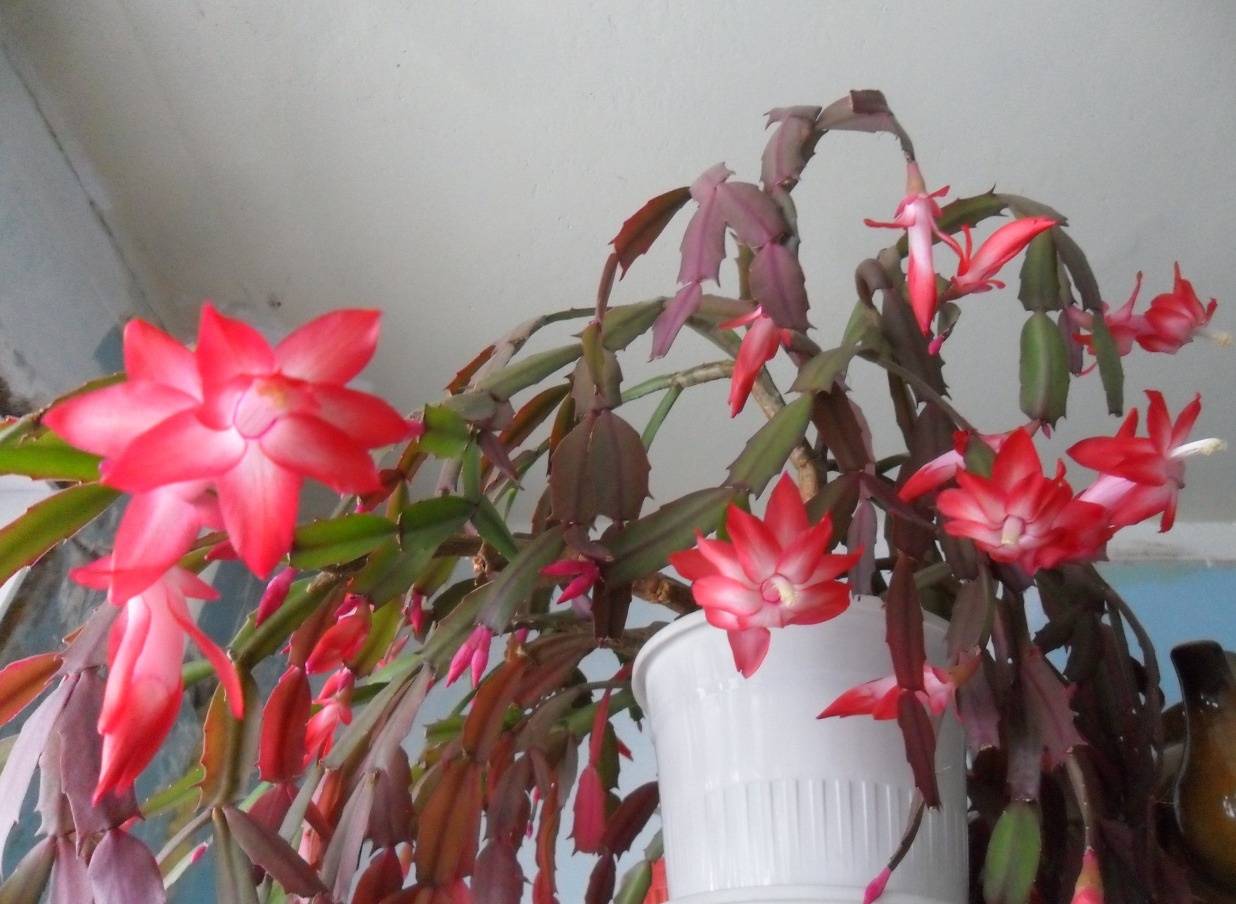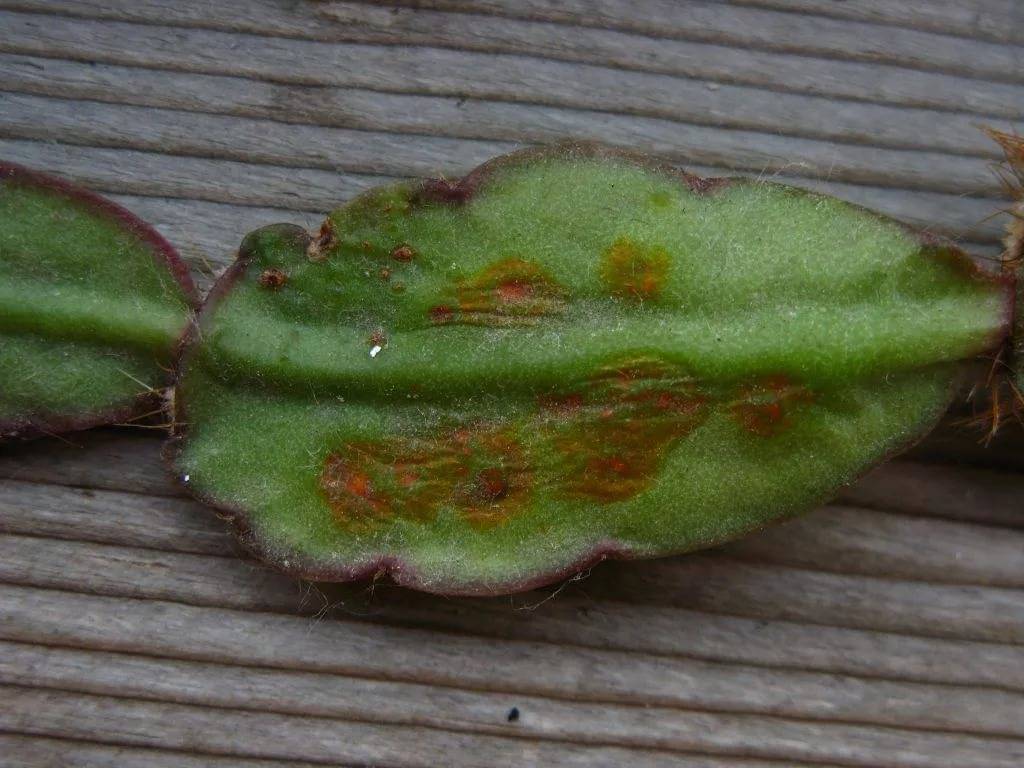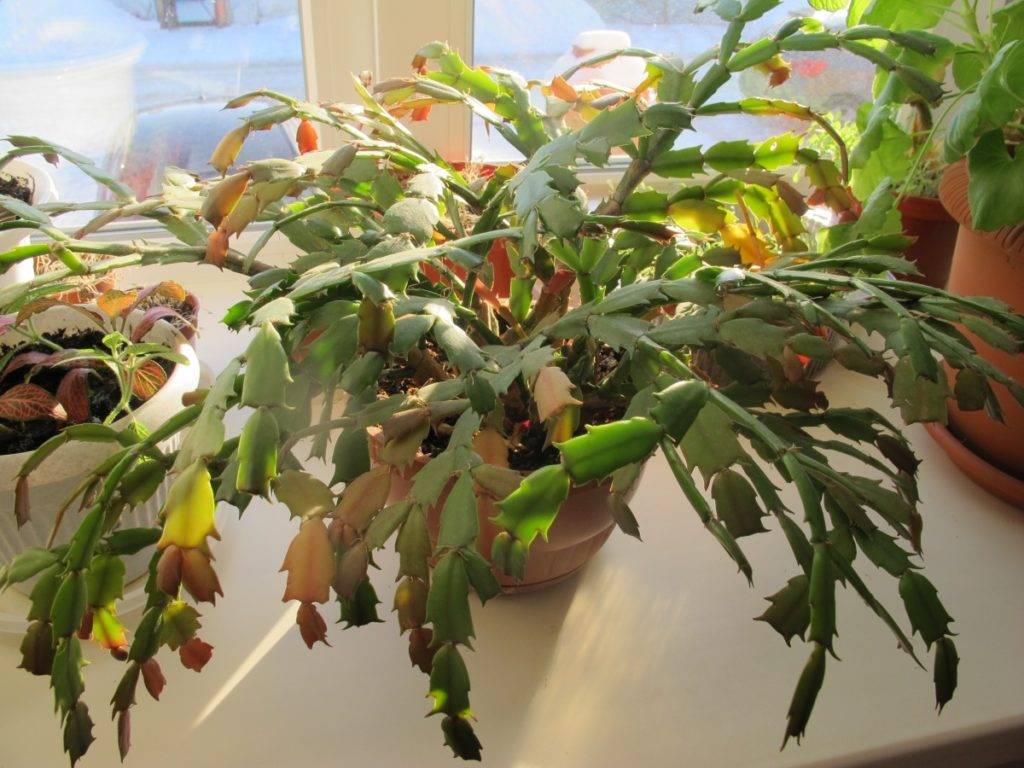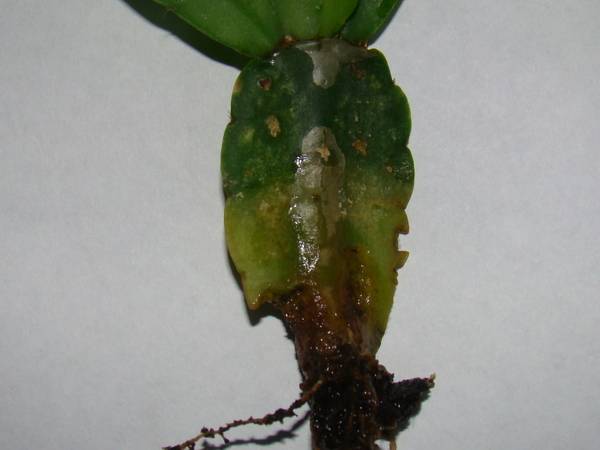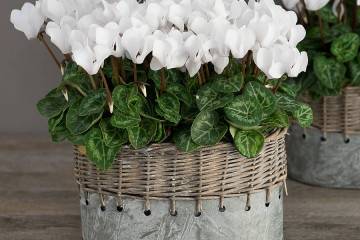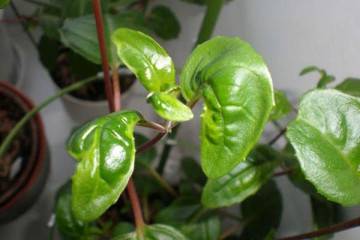Why do the Decembrist's leaves wither and fall - what to do
Content:
The Decembrist is a beautiful houseplant belonging to the group of succulents. The flower acquired its name for the lush bloom in the month of the same name. He is also called Schlumberger, Christmas and Zygocactus. The article below tells everything about the Decembrist flower, caring for it at home and why it withers if all conditions are met.
Brief description of the flower
The leaves are flat segments with jagged edges on the sides. During flowering, a bud forms at the tip of the last shoot segment. The flower petals are rather large, reaching up to 8 cm in length. Depending on the variety, the buds come in different colors for every taste. However, the Decembrist will delight only if he is provided with proper care.
The Decembrist has problem leaves: what could be the reasons
The main problems include reddening of the leaves of the Decembrist. The health of a flower directly depends on the conditions of keeping and caring for it.
First you need to determine the reason why the Decembrist's leaves turn red. This can be influenced by:
- bright sunlight. Decembrist is a shade-loving plant. For growing it at home, western or eastern windows are suitable, and in the summer it is better to rearrange the plant to the north side of the apartment. If the flower is not shaded in the summer, then purple or red spots will appear on its leaves. Gradually, the segments will turn red completely and begin to fall off. These are clear signs of sunburn;
- growth of new segments. If the problem appeared on the tips of the leaves in the spring, then you should not panic why the Decembrist's leaves turn red and what to do about it. At this time, the growing season of the plant begins. Redness in this case is due to the formation of new segments;
- improper feeding. It is recommended to feed the plant with fertilizers for cacti, succulents from mid-October until its flowering. If fertilizer is applied at the correct time interval, then a red leaf may indicate a lack of phosphorus in the soil;
- excessive watering. The Decembrist loves moisture, but you should not get carried away with watering. Stagnant moisture destroys the roots, which affects the color of the foliage;
- hypothermia. Low temperatures and drafts are detrimental to the plant. Due to non-observance of the temperature regime, the flower turns red.
Thus, there are many reasons. To revive the flower, you need to competently approach the problem, and then use the step-by-step instructions for resuscitating the Decembrist. As originally stated, the plant needs proper care. Having corrected the errors of the conditions of detention, you can return the zygocactus to its original appearance.
So, the Decembrist's leaves turned red, what should I do? The algorithm of actions for a flooded plant is as follows:
- Inspection of the flower for the presence of pests and subsequent processing if they are detected.
- Preparation of new soil, scissors, antiseptic (ash, brilliant green).
- Removing a plant from a flowerpot, cleaning the roots from excess soil.
- Rinsing the root system under running warm water.
- Inspection for root decay.
- Removal of damaged fragments with scissors.
- Treatment of sections with an antiseptic.
- Air drying the plant for 2-4 hours.
- Drainage device in a pot, covering it with a layer of soil.
- Placing flower roots in a flowerpot, dusting with earth.
You can help a supercooled flower by transplanting it using the re-rooting method:
- Pinch off a few healthy leaves, place them in water. After 2 weeks, roots will appear on them.
- Plant the leaves in a pot with drainage, covering with soil for cacti.
- Drizzle with a little warm water.
- Transplant the old flower into fresh soil and water. After transplanting, do not feed for a month.
Diseases
Diseases of the Decembrist can be fungal and bacterial in nature. They are manifested by the appearance of spots of different sizes, colors on the surface of leaves and buds. Treatment depends on the type of illness.
The plant is bothered by such fungal diseases as late blight, phytium and fusarium. The first two come in with infected soil and damage the root system first. Fall of segments, wilting of buds and gray (pale) color of the plant are sure signs of fungal infection. The Decembrist is withering, what to do? You can help the flower by treating it with the following drugs: scor, topaz, maxim, vitaros.
The fungus of the latter penetrates not only with the soil, but also through the wounds of the zygocactus, which leads to decay of the roots and neck of the plant.
The bacterial infection is caused by Erwinia bacteria. A moist dark spot forms at the base of the stem, which subsequently covers the entire plant. The flower gradually takes on a red-purple hue. The defeat by bacteria is one of the most common reasons why the leaves of the Decembrist turned red. Treating infected areas is useless. They should be removed or a healthy cutting should be removed and a new plant grown from it.
Pests
There are a number of pests that annoy the flower. At the same time, the Decembrist throws off the leaves, trying to heal on his own. Frequent close inspection of the leaves will help detect the problem in time and solve it.
- Mealybug. White sticky mucus on the leaves indicates the appearance of this parasite. It has an oval pink body with stripes ranging in size from 3 to 7 mm. To get rid of it, the plant is sprayed with actara or confidor. From folk remedies, an infusion of 25 g of garlic (or 40 ml of olive oil) with 1 liter of boiled water, applied with a cotton pad to the leaves of the plant, helps. Spraying with a solution of 15 g of green soap and 1 liter of water is also effective;
- Shield. This pest with a dark brown shield literally sucks out all the juices from the plant. If no rescue measures are taken, Schlumberger may die. You can overcome the scale insect by treating the flower with a swab dipped in karbofos, ankara, tanker. From folk remedies, you can resort to a solution of 1 liter of water and 40 g of laundry soap and 5 drops of kerosene, a strained solution from a finely chopped onion and a glass of water. After processing, the plant must be placed for a while under direct sunlight and the humidity must be at least 60%;
- Spider mite. The presence of a rusty coating and cobweb indicates the appearance of a pest of yellow-brown or red color. The main reason for its appearance is dryness in the room. To save the plant, you must first wash it with a solution of laundry soap, then lather and leave for 2 hours. Then rinse with water and put on a plastic bag for 10 days. After a week, repeat the procedure. It can also be treated with specialized solutions: fitoverm, neoron, actellik.Knowing the cause of the mite, you need to increase the humidity in the room, for example, by spraying a flower.
Soil moisture
Despite the fact that the Decembrist belongs to the Cactus family, it requires abundant and systematic watering, especially in summer and spring. In these seasons, it is recommended to water the zygocactus every 3-5 days in small portions. During the growing season, watering is reduced to moderate, once a week is enough. Autumn is the dormant period for the flower, which lasts until mid-November. Therefore, watering should be reduced to a minimum or just spraying should be done.
It is necessary to water the plant when the earth is completely dry. The signal for watering is the drying of the topsoil by 3-4 cm. Water for irrigation should be soft and at room temperature. It should be well defended. You can use thawed.
One third of the flowerpot should be filled with drainage, such as broken brick, coal, or gravel. It will protect the soil from waterlogging, eliminate stagnant water. The flower will receive the amount of moisture it needs.
Air temperature
It is hard to believe that in nature there are moisture-loving cacti without thorns that cannot stand the sun. Well, another myth has been dispelled: the association of a cactus with a hot desert. The sun and a hot battery are dangerous for the Decembrist.
Required temperature range:
| Temperature | Influence on the plant |
| <10 ° C | Prevents the appearance of buds |
| 10-15 ° C | Favorable temperature for flowering |
| 15-23 ° C | Comfortable temperature for growth |
| > 23 ° C | The establishment of peduncles is excluded. High temperature is the cause of lethargy and dryness of the leaves, and together with an excess of moisture, it contributes to decay of the roots. |
Decay of roots
In addition to infections, there are other causes of the Decembrist's illness.
- flooding the soil. In winter, the Decembrist needs less water. Its flooding is fraught with soil acidification. At low temperature conditions, the process occurs several times faster. Not receiving nutrition from the root system, the flower withers. Leaves fall;
- fertilizer abuse. Top dressing should be moderate, its excess literally burns the roots;
- overheat. With prolonged exposure to direct sunlight, the roots prey in the presence of moisture in the pot or burn out in the absence of moisture.
Knowing the reason, it is worth changing the conditions for keeping the plant: follow the rules of watering, do not get carried away with fertilizing, rearrange the flower in the shade. In the summer, you can take the flower outside to ventilate. This will eliminate soil acidification. If these measures do not help, you should transplant the flower or put it on the processes by cuttings (there should be at least 3 segments on one cuttings).
Other possible problems and what to do to fix them
In addition to all of the above, a flower may have:
- lethargic and dry leaves.Wrinkled sluggish leaves on the Decembrist with signs of drying indicate unbalanced watering, a possible location near dry hot air (near a battery) or under scorching sunlight;
- leaves fall. Decembrist sheds leaves due to the appearance of pests, lack of nutrients, stress due to sudden changes in temperature and untimely transplantation;
- thin leaves. The problem is observed with the appearance of parasites in the soil and insufficient feeding in the form of mineral and organic fertilizers;
- the leaves turn yellow. An insufficient level of air and soil moisture, a lack of trace elements can provoke yellowing of the Decembrist leaves. It is also possible the presence of a pest - scale insects.
Sometimes it happens that the plant looks healthy, but for some reason the Decembrist does not grow. The reason may be in a cramped pot, and the flower needs replanting. The soil becomes compacted over time and ceases to pass the required amount of air, and sometimes the root system fills the entire container and becomes cramped for it. A young Decembrist needs to be transplanted into a new flowerpot once a year, mature - once every 4-5 years.
Thus, many fungal and bacterial diseases, as well as pests, are bothering the Christmas tree. Only a thorough inspection of the plant will allow you to detect the problem in time and solve it. However, it is important not to overflow the flower, since the plant has a very sensitive root system, excess moisture will lead to its decay. It is better to use a pallet for watering.
A shade-loving plant will not withstand direct sunlight and heat indoors. Moving from a familiar place can also be disastrous. Do not forget to feed the flower with mineral fertilizers and repot it periodically. With proper care, the flower will not keep you waiting long: when the coldest time of the year comes outside the window, the Decembrist will begin to bloom and appear before in all its glory.
